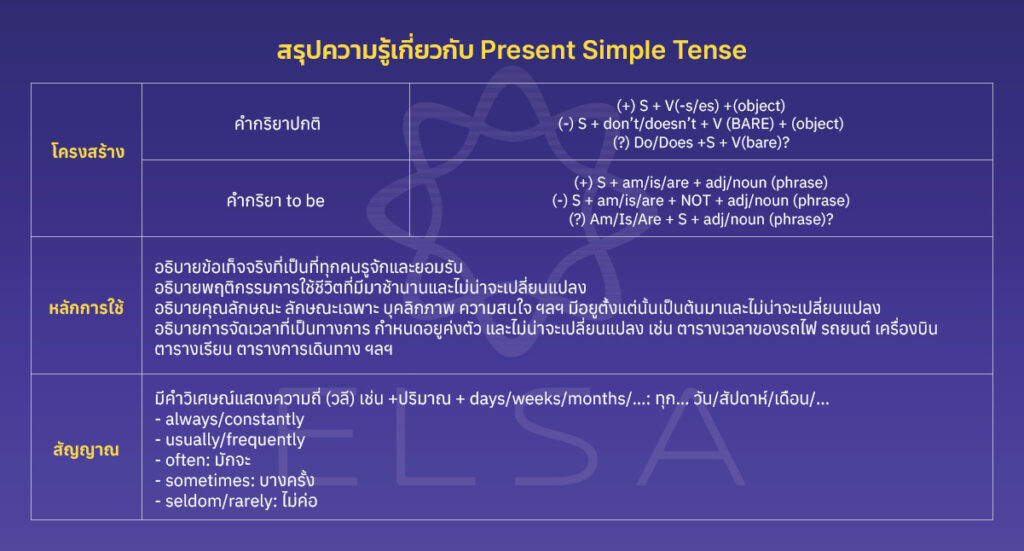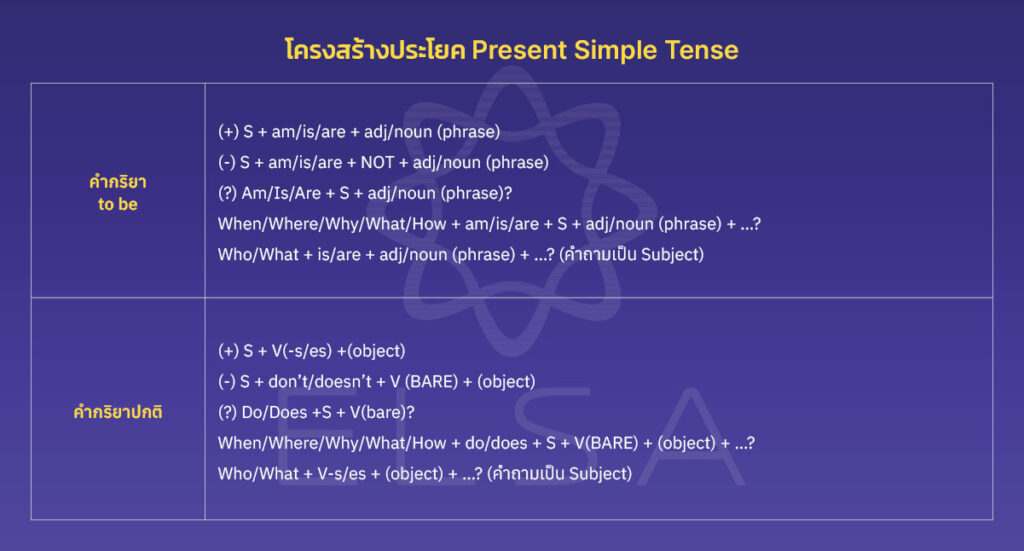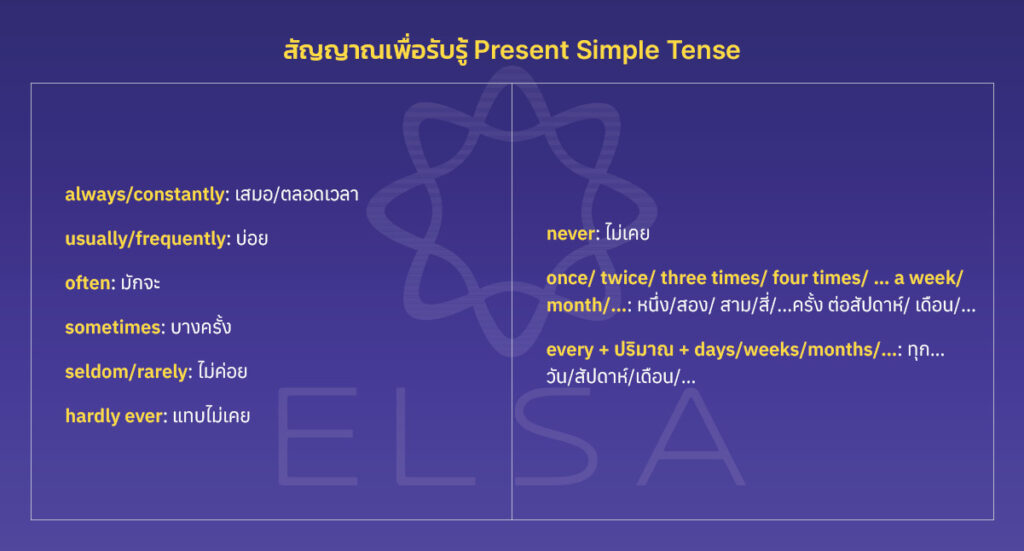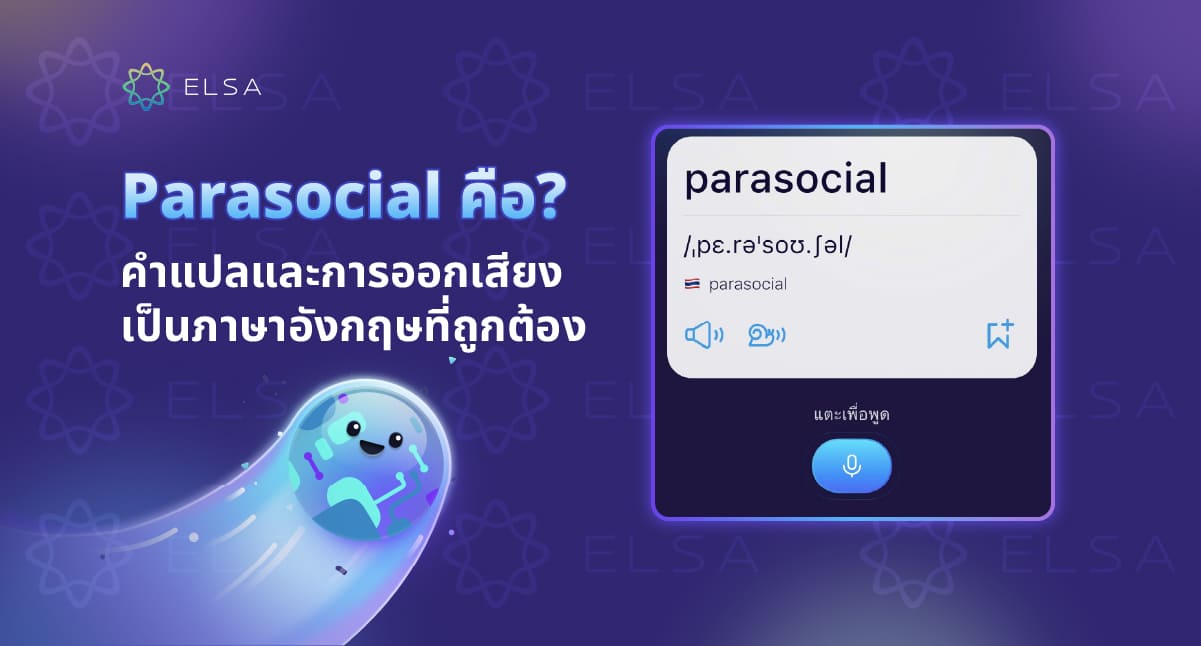Present Simple Tense เป็นไวยากรณ์พื้นฐานที่สุดที่ใครก็ตามที่เรียนภาษาอังกฤษจะได้เรียนตั้งแต่แรก นอกจากนี้ยังเป็นกาลพื้นฐานและใช้บ่อยที่สุดในทั้งหมด 12 กาลภาษาอังกฤษ
อย่างไรก็ตาม เพื่อที่จะใช้ Present Simple Tense ในการเขียนหรือการพูด เราจำเป็นต้องรู้วิธีการผันคำกริยาใน Present Simple Tense อ่านบทความต่อไปนี้เพื่อเรียนรู้เพิ่มเติม!

Present Simple Tense คืออะไร?
Simple Present Tense คือประโยคที่มีหน้าที่แสดงสิ่งที่เป็นจริงเกือบตลอดเวลา เปลี่ยนแปลงยาก โดยเฉพาะในปัจจุบัน เช่นข้อเท็จจริงที่รู้แจ้งและทราบกันโดยทั่วไป หรือนิสัย คุณลักษณะ ลักษณะเฉพาะ… ของมนุษย์
Present Simple Tense ตัวอย่างประโยค:
- Russia is the largest country in the world.
(รัสเซียเป็นประเทศที่ใหญ่ที่สุดในโลก) → ความจริงที่ชัดเจน
- My father usually wakes up at 7:30.
(พ่อของฉันมักจะตื่นนอนเวลา 7:30 น.) → นิสัยของคนๆ หนึ่ง
โครงสร้างประโยค Present Simple Tense

Present Simple Tense โครงสร้างประโยคบอกเล่า
| คำกริยา be | คำกริยาปกติ |
|---|---|
| S + am/is/are + adj/ N(phrase) | S + V(-s/es) + (object) |
| ตัวอย่าง His father is very strict. I am a college student. | ตัวอย่าง I have a small villa in Huahin. She plays tennis very well. |
ตารางประธานและกริยาที่สอดคล้องกับประโยคที่ใช้กริยา be:
| Subject | Verb to be |
| I | am |
| WeYouThey/My parents/Our teachers/… | are |
| He/She/It/Mybrother/The cat/… | is |
ตารางประธานและกริยาที่สอดคล้องกับประโยคที่ใช้กริยาปกติ:
| Subject | Verb |
| I, We, You, They/My parents/Our teachers/… | V-inf |
| He/She/It/Mybrother/The cat/… | V-s/es |
>>> อ่านเพิ่มเติม:
Irregular Verbs ในภาษาอังกฤษที่ครบถ้วนที่สุด
Modal Verb คืออะไร? คำจำกัดความ ตัวอย่าง วิธีใช้งานที่เข้าใจง่าย
Present Simple Tense โครงสร้างประโยคปฏิเสธ
| คำกริยา be | คำกริยาปกติ |
|---|---|
| S+ am/is/are + NOT + adj/ N(phrase) | S + don’t/ doesn’t + V(BARE) + (object) |
| ตัวอย่าง His father isn’t strict. I am not a college student. | ตัวอย่าง I don’t have a small villa in Huahin. She doesn’t play tennis well. |
*หมายเหตุ:
I am not= I’m not
are not= aren’t
is not= isn’t
Present Simple Tense โครงสร้างประโยคคำถาม
1. คำกริยา ‘be’
ก. คำถาม Yes-No:
| Am/Is/Are + S+ adj/noun(phrase) ? |
| Yes, S + am/is/are. No, S + am/is/are + not |
ตัวอย่าง:
1. Is that lady your aunt? (ผู้หญิงคนนั้นเป็นน้าของคุณใช่ไหม?)
→ Yes, she is (ใช่)
2. Are they your brothers? (พวกเขาเป็นพี่น้องของคุณใช่ไหม?)
→ No, they aren’t (ไม่ใช่)
ข. คำถาม Wh- ของ “be”
| กลุ่มที่ 1 | When/Where/Why/What/How + am/is/are + S + adj/noun (phrase) + …? |
| กลุ่มที่ 2 | Who/What + is/are + adj/noun (phrase) + …? (คำถามเป็น Subject) |
ตัวอย่าง:
- What are you interested in? (คุณมีความสนใจกับอะไรบ้าง?)
- What are your interests? (งานอดิเรกของคุณคืออะไรบ้าง?)
- Why is she here? (เธอมาที่นี่ทำไม?)
- Where are your parents? (พ่อแม่ของคุณอยู่ที่ไหน?)
2. คำกริยาปกติ (Action Verbs):
ก. คำถาม Yes-No:
| Do/Does + S + V(bare) ? |
| Yes, S + do/does. No, S + don’t/doesn’t |
ตัวอย่าง:
1. Does your mother play sports? (แม่ของคุณเล่นกีฬาใช่ไหม?)
→ Yes, she does (ใช่)
2. Do your teachers give you homework? (คุณครูของคุณให้การบ้านไหม?)
→ No, they don’t (ไม่ได้ให้)
ข. คำถาม Wh- ของ “คำกริยาปกติ”:
| กลุ่มที่ 1 | When/Where/Why/What/How + do/does + S + V(BARE) + (object) + …? |
| กลุ่มที่ 2 | Who/What + V-s/es + (object) + …? (คำถามเป็น Subject) |
ตัวอย่าง:
- Who washes the dishes in your family? (ใครล้างจานในครอบครัวของคุณ?)
- Where do you usually go on weekends? (คุณมักจะไปที่ไหนในวันหยุดสุดสัปดาห์?)
เข้าใจแนวทางการใช้กาลต่างๆในภาษาอังกฤษอย่างมั่นคง:
- ประโยคอดีตกาลต่อเนื่อง (Past Continuous Tense): โครงสร้างและแบบฝึกหัด
- ประโยคอนาคตกาล ( Future Simple Tense ): โครงสร้างและแบบฝึกหัด
- Present Continuous Tense: โครงสร้าง หลักการใช้งาน
- Past Perfect Continuous Tense
- ประโยคปัจจุบันกาล (Present Simple Tense): โครงสร้าง การใช้งาน
- อนาคตกาลสมบูรณ์ต่อเนื่อง (Future Perfect Continuous Tense)
- Future Continuous Tense: โครงสร้างและหลักการใช้งาน

หลักการใช้ Present Simple Tense
Present Simple Tense สรุปกรณีที่พบบ่อยที่สุด:
1. อธิบายข้อเท็จจริงที่ทุกคนรู้จักและยอมรับ:
Vatican City is the smallest country in the world (Vatican City เป็นประเทศที่เล็กที่สุดในโลก)
The ozone layer protects the earth from the sun (ชั้นโอโซนปกป้องโลกจากแสงแดด)
2. อธิบายพฤติกรรมการใช้ชีวิตที่มีมาช้านานและไม่น่าจะเปลี่ยนแปลง:
My parents go swimming every Sunday (พ่อแม่ของฉันไปว่ายน้ำทุกวันอาทิตย์)
She doesn’t stay up late (เธอไม่นอนดึก)
3. อธิบายคุณลักษณะ ลักษณะเฉพาะ บุคลิกภาพ ความสนใจ ฯลฯ มีอยู่ตั้งแต่นั้นเป็นต้นมาและไม่น่าจะเปลี่ยนแปลง:
My co-workers are very kind (เพื่อนร่วมงานของฉันใจดีมาก)
That employee doesn’t like meetings (พนักงานคนนั้นไม่ชอบการประชุม)
4. อธิบายการจัดเวลาที่เป็นทางการ กำหนดอยู่คงตัว และไม่น่าจะเปลี่ยนแปลง เช่น ตารางเวลาของรถไฟ รถยนต์ เครื่องบิน ตารางเรียน ตารางการเดินทาง ฯลฯ
The concert starts at 7 this evening (รายการดนตรีเริ่มเวลาหนึ่งทุ่มคืนนี้)
Our evening English classes finish at 9:20 (ชั้นเรียนภาษาอังกฤษภาคค่ำของเราสิ้นสุดเวลา 21:20 น.)
สรุป Present Simple Tense สัญญาณการรับรู้
Present Simple Tense สามารถรับรู้ได้จากโครงสร้างในส่วนที่ 2
ประโยคอาจมีคำวิเศษณ์แสดงความถี่ (วลี) เช่น:
- always/constantly: เสมอ/ตลอดเวลา
- usually/frequently: บ่อย
- often: มักจะ
- sometimes: บางครั้ง
- seldom/rarely: ไม่ค่อย
- hardly ever: แทบไม่เคย
- never: ไม่เคย
- once/ twice/ three times/ four times/… a week/month/…: หนึ่ง/สอง/ สาม/สี่/…ครั้ง ต่อสัปดาห์/ เดือน/…
- every + ปริมาณ + days/weeks/months/…: ทุก… วัน/สัปดาห์/เดือน/…

ประธานพหูพจน์และประธานเอกพจน์คืออะไร?
สามารถอธิบายประธานพหูพจน์และประธานเอกพจน์โดยย่อในแผนภาพด้านล่าง
ประธานเอกพจน์ไปกับกริยาเอกพจน์ (กริยาตามด้วย -s/es) ประธานพหูพจน์จะไปกับกริยาพหูพจน์ (infinitives ไม่ต้องเติม -s/es)
หมายเหตุ: คุณอาจสงสัยว่าเหตุใด ‘I’ และ ‘You’ ถูกจัดเป็นสรรพนามพหูพจน์ ทั้งๆ ที่ ‘I’ เป็นประธานเอกพจน์บุรุษที่หนึ่ง และ ‘You’ เป็นประธานบุรุษที่ 2 ของทั้งพหูพจน์และเอกพจน์ ก็เพราะตามกฎของไวยากรณ์ แม้ว่า ‘I’ และ ‘You’ จะกล่าวถึงบุคคล/สิ่งของ แต่ก็ยังต้องไปกับกริยาพหูพจน์ (infinitive)
ประธานพหูพจน์
| คำนามนับได้พหูพจน์ | ตัวอย่าง |
|---|---|
| They | They want the employees to be more hardworking. (พวกเขาต้องการให้พนักงานทำงานขยักมาดขึ้น) |
| We | We plan to finish this project next week. (เราวางแผนที่จะเสร็จสิ้นโครงการนี้ในสัปดาห์หน้า) |
| I | I love to work for this company. (ฉันชอบทำงานให้กับบริษัทนี้) |
| คำนามนับได้พหูพจน์ | ตัวอย่าง |
|---|---|
| Employees | Employees expect to receive their monthly salary on the fifth. (พนักงานคาดว่าจะได้รับเงินเดือนในวันที่ห้า) |
| John and Mary | John and Mary meet their clients every day. (John และ Mary พบลูกค้าของพวกเขาทุกวัน) |
ประธานเอกพจน์
| คำนามนับได้พหูพจน์ | ตัวอย่าง |
|---|---|
| He | He serves his customers really well. (เขาให้บริการลูกค้าได้ดีจริงๆ) |
| She | She knows how to build relationships with her clients. (เธอรู้วิธีสร้างความสัมพันธ์กับลูกค้า) |
| It | It doesn’t work out. (มันไม่ได้ผล) |
| คำนามนับได้เอกพจน์ | ตัวอย่าง |
|---|---|
| Supervisor Each Everyone/Someone No one/Anyone | Our supervisor is a capable person. (หัวหน้างานของเราเป็นคนที่มีความสามารถ) |
| คำนามนับได้เอกพจน์ | ตัวอย่าง |
|---|---|
| Money | Money is really important in our field. (หัวหน้างานของเราเป็นคนที่มีความสามารถ) |
| Advice | His advice is really useful when we deal with tough customers. (คำแนะนำของเขามีประโยชน์มากเมื่อเราเจรจากับลูกค้าที่ใจแข็ง) |
Present Tense สรุปกรณีพิเศษ
| กฎ | ตัวอย่าง |
|---|---|
| เมื่อคุณเห็น of อย่าลืมให้ความสนใจกับคำนามข้างหน้า of ให้ผันกริยาตามคำนามนั้น | – A bouquet of yellow roses lends color and fragrance to the meeting room. (ช่อดอกกุหลาบสีเหลืองนำสีสันและกลิ่นหอมมาสู่ห้องประชุม) – Two bags of cash have been received by the managers. (ผู้จัดการได้รับเงินสดสองถุงแล้ว) |
| เมื่อคุณพบ or หรือ nor อย่าลืมสังเกตคำนามที่ใกล้กับคำกริยามากที่สุดและผันคำกริยาตามคำนั้น | – Either Kiana or Casey helps today with stage decorations. (วันนี้ Kiana หรือ Casey จะช่วยตกแต่งเวที) – The managers or the board don’t approve his proposal. (ผู้จัดการหรือคณะกรรมการไม่อนุมัติข้อเสนอของเขา) – Neither John nor his teammates agree with the supervisor’s decision. (ทั้งจอห์นและเพื่อนร่วมทีมของเขาไม่เห็นด้วยกับการตัดสินใจของหัวหน้างาน) |
| คำนามบอกเวลา เงิน ระยะทาง น้ำหนัก และปริมาณเป็นเอกพจน์ | – Five years is long enough for him to think of making a career change. (ห้าปีนานพอที่เขาจะคิดเรื่องเปลี่ยนอาชีพ) – Five kilometers is too far to walk. (ห้ากิโลเมตรไกลเกินไปที่จะเดิน) |
| อย่าลืมสังเกตคำนามที่อยู่หลัง a lot of, some of, all of, none of, half of ผันกริยาตามคำนามนั้นๆ | – All of the chicken is gone. (ไก่ทั้งหมดหายไปแล้ว) – All of the chickens are gone. (ไก่ทั้งหมดหายไปแล้ว) – Some of the pie is missing. (บางส่วนของพายหายไป) – Some of the pies are missing. (พายบางส่วนหายไป) |
การแยกแยะ Present Simple Tense และ Present Continuous Tense
ตารางการแยกแยะโครงสร้างและฟังก์ชั่นของ Present Simple Tense และ Present Continuous Tense
| Present Simple Tense | Present Continuous Tense |
|---|---|
| ใช้โครงสร้างในส่วนที่ 2 | โครงสร้างที่มี: am/is/are (not) + V-ing |
| Present Simple Tense ไม่ได้พูดถึงการกระทำที่เกิดขึ้นในขณะที่พูดหรือในช่วงเวลาที่พูด | ฟังก์ชั่นหลักคือการอธิบายเหตุการณ์/การกระทำที่เกิดขึ้นในขณะที่พูดหรือในช่วงเวลาที่พูด ตัวอย่าง: My father is cooking at the moment. (พ่อของฉันกำลังทำอาหารอยู่ตอนนี้) These days, I’m reading a good book. (ช่วงนี้ฉันกำลังอ่านหนังสือดีๆ อยู่เล่มหนึ่ง) |
แบบฝึกหัดและคำตอบเกี่ยวกับ Present Simple Tense
1. แบบฝึกหัด
ผันคำกริยาใน (…)
1. My uncle ………… (be) a graphic designer.
2. David ………… (get) up at 5:30. He ………… (drink) some water and ………… (start) doing yoga.
3. Our teachers ………… (be) caring and supportive. They always ………… (ask) if we need their help.
4. My best friend Anna always ………… (stay) up late.
5. We ………… (not enjoy) going out on weekends because it ………… (be) very crowded.
6. Her parents ………… (not allow) her to go out after 9pm.
7. Emma ………… (not eat) fast foods. She ………… (know) they’re not good for her health.
8. That employee ………… (not be) responsible.
9. Our son ………… (watch) TV a lot. That ………… (be) absolutely unhealthy.
10. My manager ………… a good leader.
ตรวจหาและแก้ไขข้อผิดพลาด บางประโยคอาจมีข้อผิดพลาดมากกว่าหนึ่งข้อ
1. Her parents aren’t go to work on Saturdays.
2. He is always feel uncomfortable at crowded places.
3. My dog barking when he see a stranger.
4. Lily live in a small coastal city.
5. My husband work for a tech company.
6. Susan and Anna goes trekking every summer.
7. His grandparents doesn’t drink coffee. They likes tea better.
8. David and I am best friends.
9. Each of the students here are confident and talented.
10. Our teacher don’t think we should go to bed after midnight.
2. คำตอบ
ผันคำกริยาใน (…)
1. My uncle is a graphic designer.
2. David gets up at 5:30. He drinks some water and starts doing yoga.
3. Our teachers are caring and supportive. They always ask if we need their help.
4. My best friend Anna always stays up late.
5. We don’t enjoy going out on weekends because it is very crowded.
6. Her parents don’t allow her to go out after 9pm.
7. Emma doesn’t eat fast foods. She knows they’re not good for her health.
8. That employee isn’t responsible.
9. Our son watches TV a lot. That is absolutely unhealthy.
10. My manager is a good leader.
ตรวจหาและแก้ไขข้อผิดพลาด บางประโยคอาจมีข้อผิดพลาดมากกว่าหนึ่งข้อ
1. Her parents aren’t go to work on Saturdays.
→ Her parents don’t go to work on Saturdays.
2. He is always feel uncomfortable at crowded places.
→ He is always uncomfortable at crowded places.
→ He always feels uncomfortable at crowded places.
3. My dog barking when he see a stranger.
→ My dog barks when he sees a stranger.
4. Lily live in a small coastal city.
→ Lily lives in a small coastal city.
5. My husband work for a tech company.
→ My husband works for a tech company.
6. Susan and Anna goes trekking every summer.
→ Susan and Anna go trekking every summer.
7. His grandparents doesn’t drink coffee. They likes tea better.
→ His grandparents don’t drink coffee. They like tea better.
8. David and I am best friends.
→ His grandparents doesn’t drink coffee. They likes tea better.
9. Each of the students here are confident and talented.
→ Each of the students here is confident and talented.
10. Our teacher don’t think we should go to bed after midnight.
→ Our teacher doesn’t think we should go to bed after midnight.
เยี่ยมชมเว็บไซต์ th.elsaspeak.com เป็นประจำเพื่อรับความรู้เพิ่มเติมเกี่ยวกับการเรียนด้วยตนเอง การสื่อสารภาษาอังกฤษ สำหรับคนวัยทำงานและวัยเรียน!









